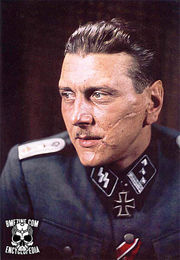Dueling Scar
At the turn of the 20th century, the dueling scar (or bragging scar, or Renommierschmiss) was popularized by upper-class Austrians and Germans who saw it as a mark of their class and honor, due to the social importance of dueling societies at Austrian universities at the time. If you were a doctor, lawyer, or professor, the dueling scar was a tattoo that signified your inclusion in an elite social rank, and visitors to university cafes would expect to see young men with bandaged faces.
The sport at the time was very different from modern fencing. The men used heavy sabers, and took turns chopping at each other five times apiece repeatedly. While padding was worn, the goal was to be injured. Kevin McAleer (author of Dueling: The Cult of Honor in Fin-de-Siecle Germany) writes,
- The idea was to stand your man and show courage—not to inflict a wound, but to be wounded. That's the very strange part of it—the true winner was he who walked away with a nice juicy scar, to show that he'd stood the test. The point was not to get the other guy, but to show that you could take it. You'd get these guys who looked like they'd walked into a propeller. It was pretty gnarly, but the guys were damn proud to look that way.
- The scars showed you had courage and education, and were good husband material. A lot of these kids were rather good-looking, and you didn't have to ruin your whole face in dueling. The scars usually accumulated on the left side of the face, so from the right profile, he still looked good. And even if it was an ugly, knotted scar, women were attracted by everything it implied, and the pride with which the wearer bore it.
Students too afraid to actually duel would cut themselves with razors or contract doctors to form the wounds, and then would repeatedly tear open the wound to irritate them, as well as using salt, wine, and even sewing horse hair into them to ensure a prominent keloid scar. It was very important for these wounds to be noticeable, as the belief was that class/caste and honor were directly linked. The dueling scar was evidence that the wearer had the foundation to fulfill his destiny as one of Germany's ruling class.
While dueling of various sorts existed around the world, the cult of the dueling scar was largely unique to central Europe (although it did exist for a brief time at other elite universities such as Oxford). Dueling cults died out by the second World War, although even today many (primarily older) Germans still consider the scars attractive, and it certainly has continued on a smaller scale. In addition, it was both fetishized and popularized through stories and films.
Chaotic Scarification
Certain activities—be it BMX racing and other extreme sports, or be it fighting or punching out windows—tend to lead to scars because of the injuries they bring. Many view these scars as desirable, and not only seek them out by putting themselves in harm's way, but by rubbing irritants into any wounds to induce them to scar.

